Prediction of the number of people with dementia
According to World Alzheimer Report 2015 from Alzheimer’s Disease International, 46.8 million people worldwide are living with dementia in 2015.
This number will almost double every 20 years, reaching 74.7 million in 2030 and 131.5 million in 2050. It is well known there is still no drug capable of improving Alzheimer’s disease.
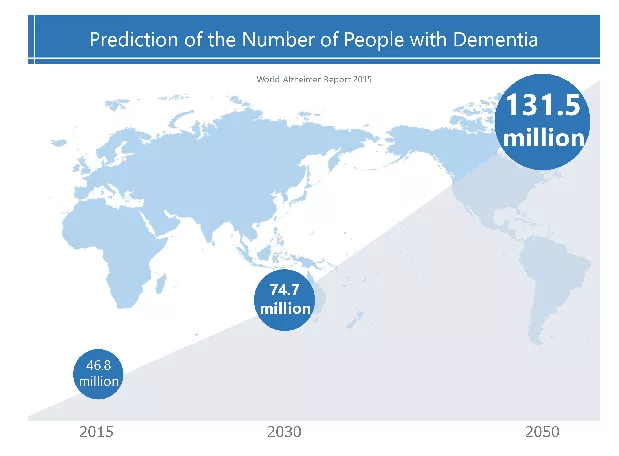
Previous Study (1)
Ginsberg has first reported the close correlation between plasmalogen and Alzheimer’s disease, that is, plasmalogen was decreased in post mortem brain samples of Alzheimer’s disease, compared with in other neurodegenerative diseases.
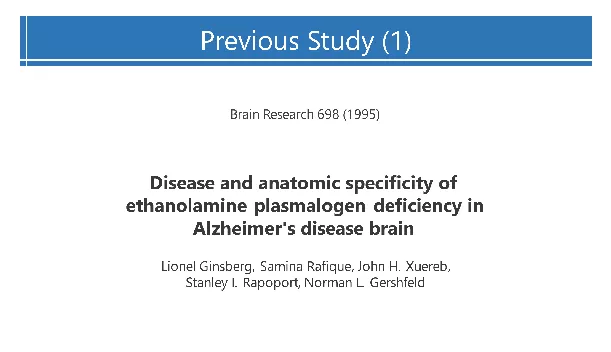
Previous Study (2)
Goodenowe showed that circulating plasmalogen was decreased in serum from patients with Alzheimer’s disease and the decrease of the plasmalogen correlated with the severity of dementia.
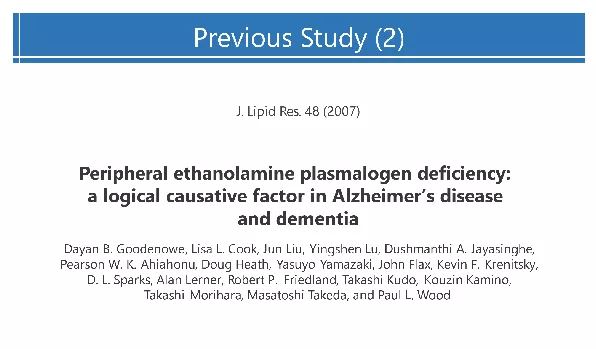
Background
First, let us begin with the background of our study. These our studies made it possible for us to perform our clinical study.
This slide outlines the progress of research on Pls, focusing on their association with Alzheimer’s disease. Research on Alzheimer’s disease was initially led by the United States; in 1995 and 1999, reduced levels of Pls in the brains of cadavers with Alzheimer’s disease were noted, and, subsequently, in 2007, reductions in the serum levels of Pls in living patients with Alzheimer’s disease were reported.
In Japan, we succeeded in developing a new, advanced detection method for Pls in 2007. We also developed a method for the extraction and production of high-purity Pls in 2009. The development of these methods facilitated the administration of Pls to animals and humans. Furthermore, we published research papers in 2012 and 2013 reporting that Pls were effective in rats with Alzheimer’s disease, and in 2012 that the levels of Pls were reduced in the erythrocytes of patients with the disease. We conducted a randomized double-blind placebo-controlled trial involving humans from Nov. 2014 to Apr. 2016
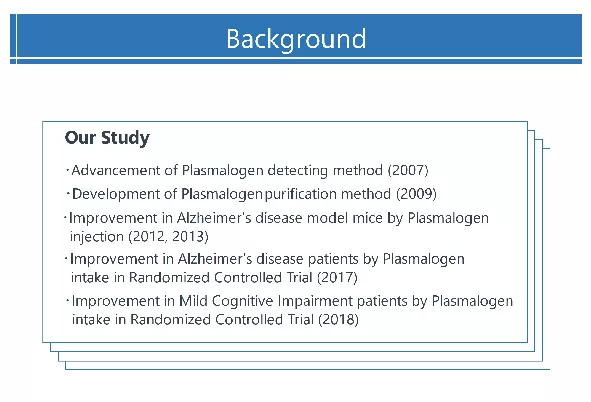
Extraction Method of Plasmalogen
It is described that high-performance liquid chromatography can separate intact
ethanolamine plasmalogens and choline plasmalogens as well as all other phospholipid classes by a single chromatographic run.
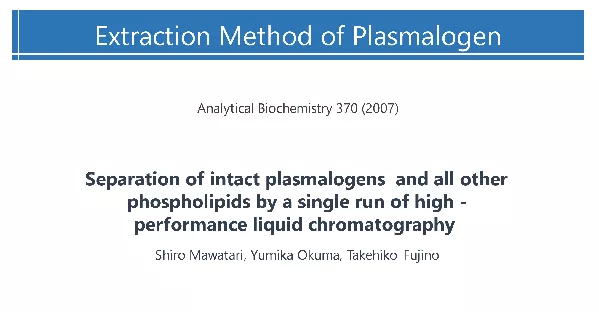
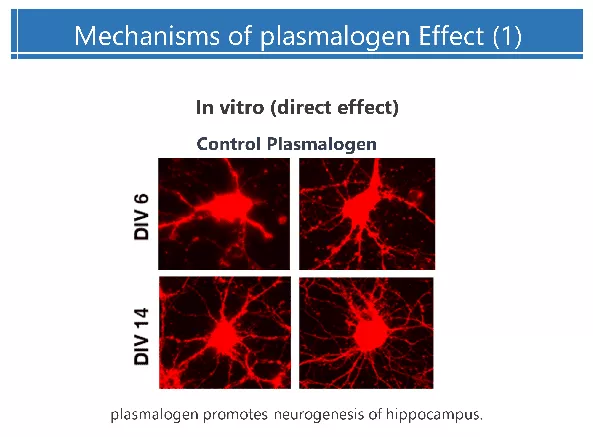
This figure explains plasmalogen enhance the neurogenesis the memory-related hippocampal cells of mice immunostaining data. As shown in the right panel, the
Plasmalogen-diet mice showed more positive neurons in the dentate gyrus, compared with normal diet.

Mechanisms of Plasmogen Effect (3)
It is already known that Lipopolysaccharide (LPS), one of inflammatory agent, promotes amyloid-β accumulations, which induce Alzheimer’s disease. As shown at the LPS column, the cell is stained green, indicating that amyloidosis took place in the CA1 area of the hippocampus, after LPS administration. In contrast, after the simultaneous administration of LPS and Plasmalogen, as shown in the LPS + Plasmalogen column, the cell was not stained green. This indicates that amyloidosis did not occur when Plasmalogen were administered.
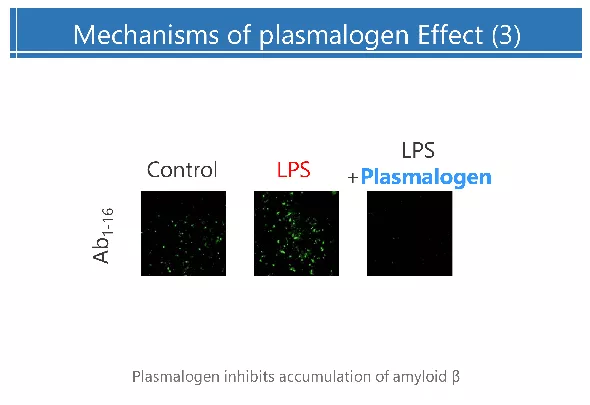
Effects of Plasmalogen in AD model Animal

Mechanisms of Pls Effect (4)
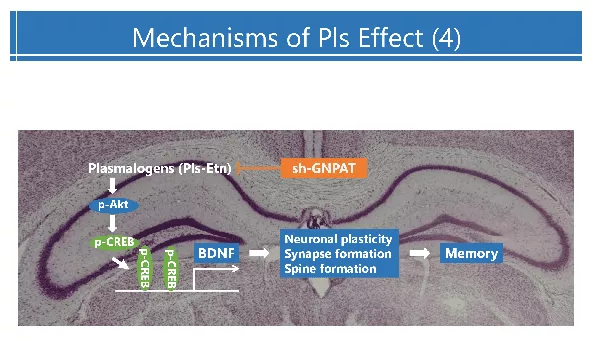
Clinical Study (RCT) of Plasmalogen (1)
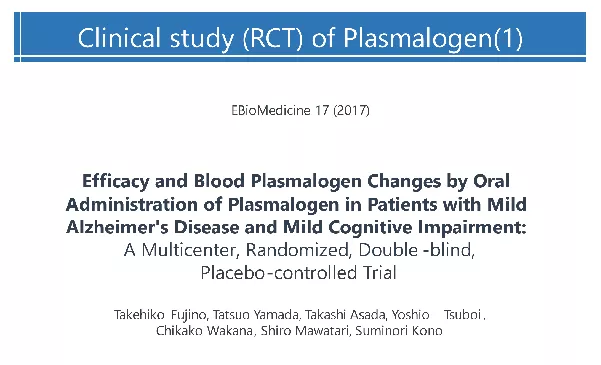
Study Design

Study Participants

Improvement of cognitive function in mild AD
The sub-analysis by sex and age in patients with mild Alzheimer’s Disease. Closed circle indicates Plasmalogen group, and open circle does placebo group, respectively. In female subjects, WMS-R, the marker of memory function, improved significantly in Plasmalogen group and there were significant differences between Plasmalogen and placebo groups as shown in the left panel. Right panel indicates the difference by age. In 77 or younger group, WMS-R significantly improved in Plasmalogen group and showed the significant differences between Plasmalogen and placebo groups.

Changes of Blood Plasmalogen
Here we did the sub-analysis by sex and age in patients with mild Alzheimer’s Disease. Closed circle indicates Plasmalogen group, and open circle does placebo group, respectively. In female subjects, WMS-R, the marker of memory function, improved significantly in Plasmalogen group and there were significant differences between Plasmalogen and placebo groups as shown in the left panel. Right panel indicates the difference by age. In 77 or younger group, WMS-R significantly improved in Plasmalogen group and showed the significant differences between Plasmalogen and placebo groups.
This slide shows the changes in plasma and erythrocyte Plasmalogen levels following oral administration of Plasmalogen. Closed circle indicates Plasmalogen group. Open circle shows placebo group. In the placebo group, Plasmalogen level in plasma significantly decreased at endpoint, and the significant difference between Plasmalogen and placebo groups was observed.

Improve of cognitive function in MCI

Clinical Study (Open-Label) of plasmalogen{2}
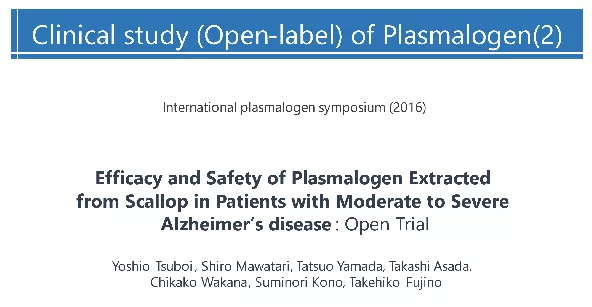
Study Participants

Study Design

Improvement of cognitive function in moderate to severe AD

Lastly, I will talk about discussion and conclusions. To our knowledge, this study is the first trial in the world that efficacy and change of blood plasmalogens by oral administration of plasmalogen were examined in patients with Alzheimer’s disease and mild cognitive impairment.
These results suggest that:
1) Oral administration of plasmalogen extracted from scallop improves cognitive functions in Alzheimer’s disease
2) Blood plasmalogen is useful for the assessment of cognitive functions, including the differentiation between Mild Cognitive Impairment and mild Alzheimer’s disease.
